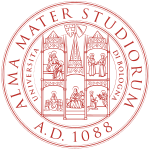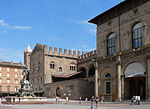Palazzo dei Notai
Buildings and structures completed in 1381Houses completed in the 14th centuryItalian palace stubsMonuments and historic places of BolognaPalaces in Bologna

Palazzo dei Notai is a historic building in Bologna, Italy. It faces Piazza Maggiore, between the basilica di San Petronio and palazzo d'Accursio. It was built in 1381 by the city's notaries guild as their seat, under design by Berto Cavalletto and Lorenzo da Bagnomarino. Another section facing Palazzo d'Accursio was remade by Bartolomeo Fioravanti around 1437. It was again restored in 1908 by Alfonso Rubbiani. It consists of a brick rectangular building, crenellated on the top, with ground story awnings. The interior has 15th-century frescoes.
Excerpt from the Wikipedia article Palazzo dei Notai (License: CC BY-SA 3.0, Authors, Images).Palazzo dei Notai
Piazza Maggiore, Bologna Irnerio
Geographical coordinates (GPS) Address Nearby Places Show on map
Geographical coordinates (GPS)
| Latitude | Longitude |
|---|---|
| N 44.493472222222 ° | E 11.3425 ° |
Address
Banca dell'Emilia
Piazza Maggiore
40121 Bologna, Irnerio
Emilia-Romagna, Italy
Open on Google Maps










